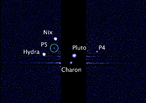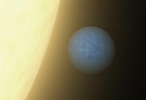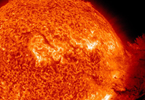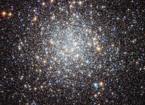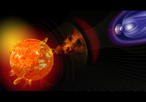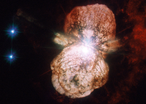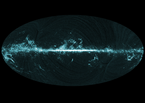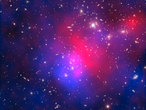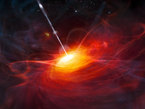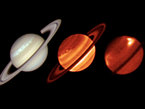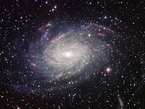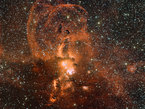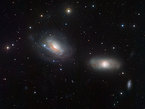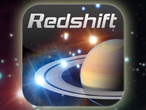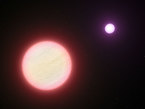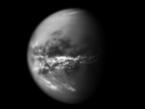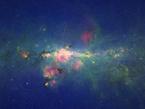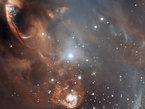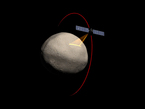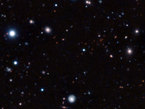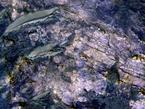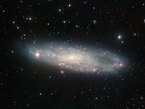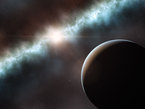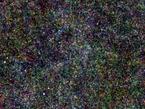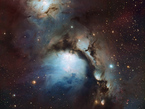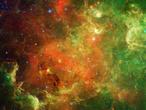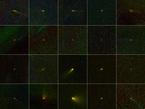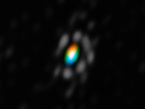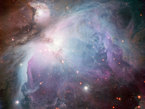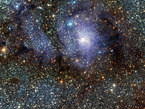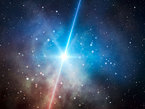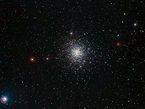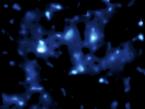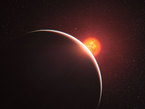Saturn
Exoplanets
La Silla Observatory
Researchers working with data from NASA's Cassini spacecraft have discovered one way the bubble of charged particles around Saturn -- known as the magnetosphere -- changes with the planet's seasons.
» more
A second look at data from NASA's Hubble Space Telescope is reanimating the claim that the nearby star Fomalhaut hosts a massive exoplanet. The study suggests that the planet, named Fomalhaut b, is a rare and possibly unique object that is...
» more
A new image from ESO’s La Silla Observatory in Chile shows the spectacular globular star cluster Messier 4. This ball of tens of thousands of ancient stars is one of the closest and most studied of the globular clusters and recent work has revealed...
» more
Exoplanets
Solar System
Spitzer
Astronomers using NASA's Spitzer Space Telescope have detected what they believe is a planet two-thirds the size of Earth. The exoplanet candidate, called UCF-1.01, is located a mere 33 light-years away, making it possibly the nearest world to our...
» more
A team of astronomers using NASA’s Hubble Space Telescope is reporting the discovery of another moon orbiting the icy dwarf planet Pluto. The moon is estimated to be irregular in shape and 6 to 15 miles across. It is in a 58,000-mile-diameter...
» more
NASA's Spitzer Space Telescope has detected light emanating from a "super-Earth" planet beyond our solar system for the first time. While the planet is not habitable, the detection is a historic step toward the eventual search for signs of life on...
» more
Solar Dynamics Observatory
Sun
Hubble
In April of 2010, NASA's Solar Dynamics Observatory (SDO) released its first images, an event known for any telescope as "first light." Since then SDO has continually observed the ever-changing sun on quiet days and explosive ones: there have been...
» more
Scientists find giant plumes on the sun, newly named "coronal cells" that are over 18,000 miles across, looking like candlesticks on a birthday cake.
» more
The NASA/ESA Hubble Space Telescope has produced the most detailed image so far of Messier 9, a globular star cluster located close to the center of the galaxy. This ball of stars is too faint to see with the naked eye, yet Hubble can see over...
» more
JWT
Solar Activities
Cosmology
The creation of the next generation James Webb Space Telescope was only possible as a result of imagining and developing the industrial machines that would make it a reality. In the near future, some of that industrial technology could be in an...
» more
Space weather starts at the sun. It begins with an eruption such as a huge burst of light and radiation called a solar flare or a gigantic cloud of solar material called a coronal mass ejection (CME). But the effects of those eruptions happen at...
» more
Astronomers using data from NASA's Hubble Telescope have observed what appears to be a clump of dark matter left behind from a wreck between massive clusters of galaxies. The result could challenge current theories about dark matter that predict...
» more
Astrophysics
Planck Mission
Mars Rover
Eta Carinae is not only interesting because of its past, but also because of its future. It is one of the closest stars to Earth that is likely to explode in a supernova in the relatively near future.
» more
New images from the Planck mission show previously undiscovered islands of star formation and a mysterious haze of microwave emissions in our Milky Way galaxy. The views give scientists new treasures to mine and take them closer to understanding...
» more
The camera at the end of the robotic arm on NASA's Mars rover Curiosity has its own calibration target, a smartphone-size plaque that looks like an eye chart supplemented with color chips and an attached penny.
» more
Mars
Pandora’s Cluster
discovery
Eight years after landing on Mars for what was planned as a three-month mission, NASA's enduring Mars Exploration Rover Opportunity is working on what essentially became a new mission five months ago.
» more
A team of scientists has studied the galaxy cluster Abell 2744, nicknamed Pandora’s Cluster. They have pieced together the cluster’s complex and violent history using telescopes in space and on the ground, including ESO’s Very Large Telescope and...
» more
A team of European astronomers has used ESO’s Very Large Telescope and a host of other telescopes to discover and study the most distant quasar found to date. This brilliant beacon, powered by a black hole with a mass two billion times that of the...
» more
ESO’s Very Large Telescope
A spiral galaxy that resembles our Milky Way
nebula NGC 3582
ESO’s Very Large Telescope (VLT) has teamed up with NASA’s Cassini spacecraft to study a rare storm in the atmosphere of the planet Saturn in more detail than has ever been possible before. The new study by an international team will appear this...
» more
ESO astronomers have used the Wide Field Imager on the MPG/ESO 2.2-metre telescope to capture an image of NGC 6744. This impressive spiral galaxy lies about 30 million light-years away in the southern constellation of Pavo (The Peacock). But this...
» more
This image of the nebula NGC 3582, which was captured by the Wide Field Imager on the MPG/ESO 2.2-metre telescope at ESO’s La Silla Observatory in Chile, shows giant loops of gas bearing a striking resemblance to solar prominences. These loops are...
» more
Curious features
Redshift for iPhone, iPod touch and iPad
Discovery
The galaxies in this cosmic pairing, captured by the Wide Field Imager on the MPG/ESO 2.2-metre telescope at the La Silla Observatory in Chile, display some curious features, demonstrating that each member of the duo is close enough to feel the...
» more
Our new Update includes a great number of features as Russian and Spanish language:
» more
Observations with the European Southern Observatory’s Very Large Telescope, along with two other telescopes, have shown that there is a new candidate for the coldest known star: a brown dwarf in a double system with about the same temperature as a...
» more
Equatorial Titan Clouds
Our Milky Way
New-born stars wreak havoc in their nursery
As spring continues to unfold at Saturn, April showers on the planet's largest moon, Titan, have brought methane rain to its equatorial deserts, as revealed in images captured by NASA's Cassini spacecraft. This is the first time scientists have...
» more
The region around the center of our Milky Way galaxy glows colorfully in this new version of an image taken by NASA's Spitzer Space Telescope.
» more
A new image from ESO’s Very Large Telescope gives a close-up view of the dramatic effects new-born stars have on the gas and dust from which they formed. Although the stars themselves are not visible, material they have ejected is colliding with...
» more
Redshift for iPhone, iPod Touch and iPad
Vesta - an asteroid in 3D
Young, but surprisingly grown-up
Since its release our Redshift App for iPhone, iPod touch and iPad has shown an unrivaled triumph. Hundreds of new users each day in 78 countries daily are exploring galaxies...
» more
What might asteroid Vesta look like? In a new animation, researchers at the German Aerospace Center (Deutsches Zentrum für Luft- und Raumfahrt; DLR) have recreated the asteroid in 3D. In the animation, the asteroid is irregularly shaped, has a...
» more
Astronomers have used an armada of telescopes on the ground and in space, including the Very Large Telescope at ESO’s Paranal Observatory in Chile to discover and measure the distance to the most remote mature cluster of galaxies yet found....
» more
Fractures in Carbonate-Bearing Rocks at Mars' Huygens Basin
A spiral galaxy
The young star T Cha
Rocks on Mars dug from far underground by crater-blasting impacts are providing glimpses of one possible way Mars' atmosphere has become much less dense than it used to be.
» more
The spiral galaxy NGC 247 is one of the closest spiral galaxies of the southern sky. In this new view from the Wide Field Imager on the MPG/ESO 2.2-metre telescope in Chile large numbers of the galaxy’s component stars are clearly resolved and many...
» more
Using ESO’s Very Large Telescope an international team of astronomers has been able to study the short-lived disc of material around a young star that is in the early stages of making a planetary system. For the first time a smaller companion could...
» more
Lockman Hole
Messier 78: a reflection nebula in Orion
An Extended Stellar Family
The Herschel Space Observatory has revealed how much dark matter it takes to form a new galaxy bursting with stars. Herschel is a European Space Agency cornerstone mission supported with important NASA contributions.
» more
The nebula Messier 78 takes centre stage in this image taken with the Wide Field Imager on the MPG/ESO 2.2-metre telescope at the La Silla Observatory in Chile, while the stars powering the bright display take a backseat. The brilliant starlight...
» more
Stars at all stages of development, from dusty little tots to young adults, are on display in a new image from NASA's Spitzer Space Telescope.
» more
NASA's NEOWISE
First "3D View" from the VLT Interferometer
The Orion Nebula
NASA's NEOWISE mission has completed its survey of small bodies, asteroids and comets, in our solar system. The mission's discoveries of previously unknown objects include 20 comets, more than 33,000 asteroids in the main belt between Mars and...
» more
The ESO Very Large Telescope Interferometer (VLTI) has made its first observations that combine super-sharp imaging with measurements of motion. New pioneering data from the VLTI/AMBER instrument not only show extremely fine details of the gas and...
» more
This ethereal-looking image of the Orion Nebula was captured using the Wide Field Imager on the MPG/ESO 2.2-metre telescope at the La Silla Observatory, Chile. This nebula is much more than just a pretty face, offering astronomers a close-up view...
» more
Our nearest large galactic neighbour
VISTA's infrared view
GROND
Two ESA observatories have combined forces to show the Andromeda Galaxy in a new light. Herschel sees rings of star formation in this, the most detailed image of the Andromeda Galaxy ever taken at infrared wavelengths, and XMM-Newton shows dying...
» more
This new infrared image of the Lagoon Nebula was captured as part of a five-year study of the Milky Way using ESO’s VISTA telescope at the Paranal Observatory in Chile. This is a small piece of a much larger image of the region surrounding the...
» more
Gamma-ray bursts are among the most energetic events in the Universe, but some appear curiously faint in visible light. The biggest study to date of these so-called dark gamma-ray bursts, using the GROND instrument on the 2.2-metre MPG/ESO...
» more
The globular star cluster Messier 107
Dark Matter Clumps
Exoplanets
We know of about 150 of the rich collections of old stars called globular clusters that orbit our galaxy, the Milky Way. This sharp new image of Messier 107, captured by the Wide Field Imager on the 2.2-metre telescope at ESO’s La Silla Observatory...
» more
Cosmologists have come up with a new way to solve their problems. They are inviting scientists, including those from totally unrelated fields, to participate in a grand competition. The idea is to spur outside interest in one of cosmology's...
» more
The atmosphere around a super-Earth exoplanet has been analysed for the first time by an international team of astronomers using ESO’s Very Large Telescope. The planet, which is known as GJ 1214b, was studied as it passed in front of its parent...
» more





